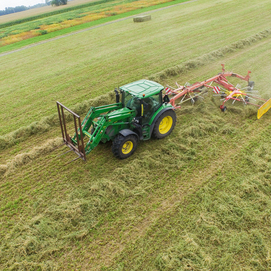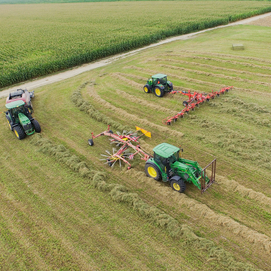Drying hay
Another important factor that limits the development
of commercial hay is, for our region, the difficulty of drying hay in a field.
Excellent quality hay requires a percentage of about 12% wen stored. Fresh
grass has a water content of between 20 and 80% when cut. After 3-4 days of
drying in the field accompanied by wilking and racking, the water content can
be lowered to around 15-20% and that is if it doesn’t rain. However, it is very
difficult to dry in the field at a level of 12%. Therefore a certain amount of
hay is wrapped with a plastic film to preserve and maintain its quality. This
technique is relatively expensive with the constant cost of plastic and poses
an environmental problem related to the disposal of the plastic after use.
All these reasons has pushed Norfoin Inc. to develop and to design hay dryer to complete the drying of the hay artificially when it is baled. The principle is such easy, we just have to push warm air trough the bale to make moisture coming out of the bales.
General Information
In
Quebec, forages are grown on about 750,000 hectares and represent a production
of about four million tons (dry basis) per year. Only 2% of this production
(about 75,000 tons/year) is produced for trade while the rest is for
self-consumption on the farm for the breeding of dairy cattle, beef cattle and
sheep.
Diversification of land for the production
of fodder
The company Norfoin Inc. continues to expand and possesses 185
acres of land for hay production in Saint-Césaire. This area of land is not sufficient to produce all the hay that we are selling. Norfoin Inc. has producers, all around Québec and Ontario, that produce hay to complete the Norfoin's inventory. Some producers are making hay for Norfoin Inc. since many years and other are new provider every year.
The diversification of our locations for hay
production allows us to provide qualitative crops, regardless of the weather.
If grasslands of Saint-Césaire are damaged by winter too tough, it is not
necessarily the case for the other land in hay in another area.
Also, during the summer, one of the regions may
receive less rainfall than the other, causing a reduction in the growth of hay,
therefore a less efficient level of production for this region. However, the
other region may receive a larger amount of rainfall ensuring a better
growth and obtaining a good harvest.
Diversifying locations of the land in different regions allows us to produce large quantities of quality
forage for animal feed.

